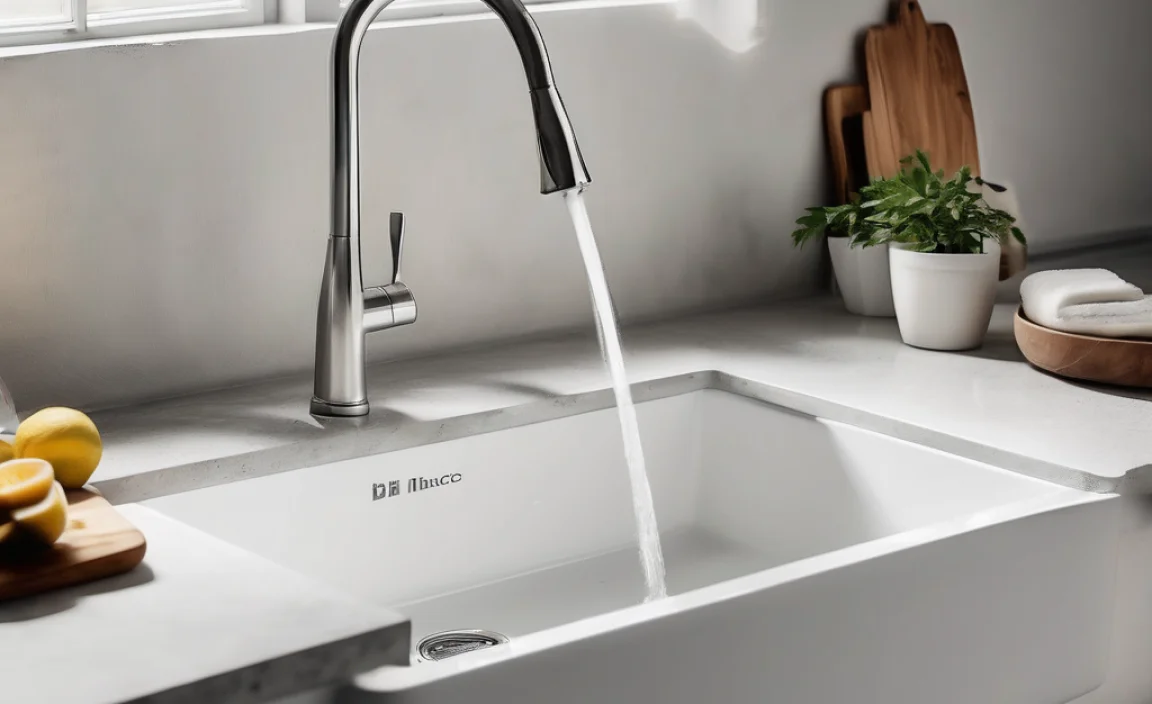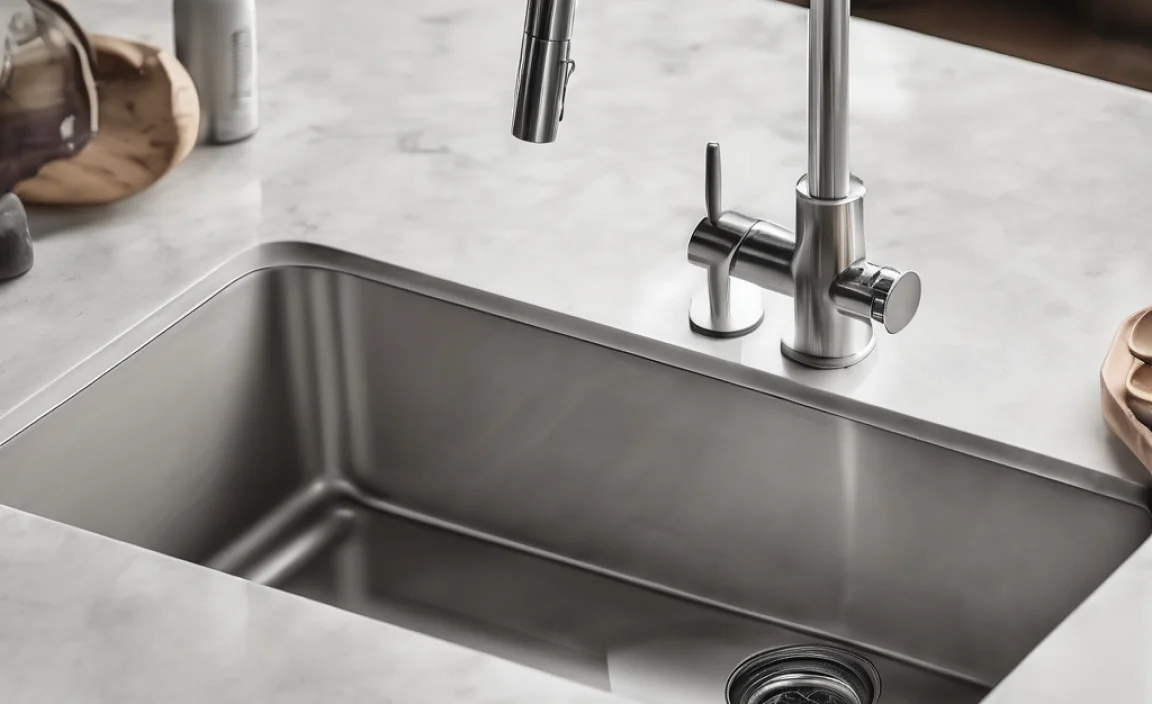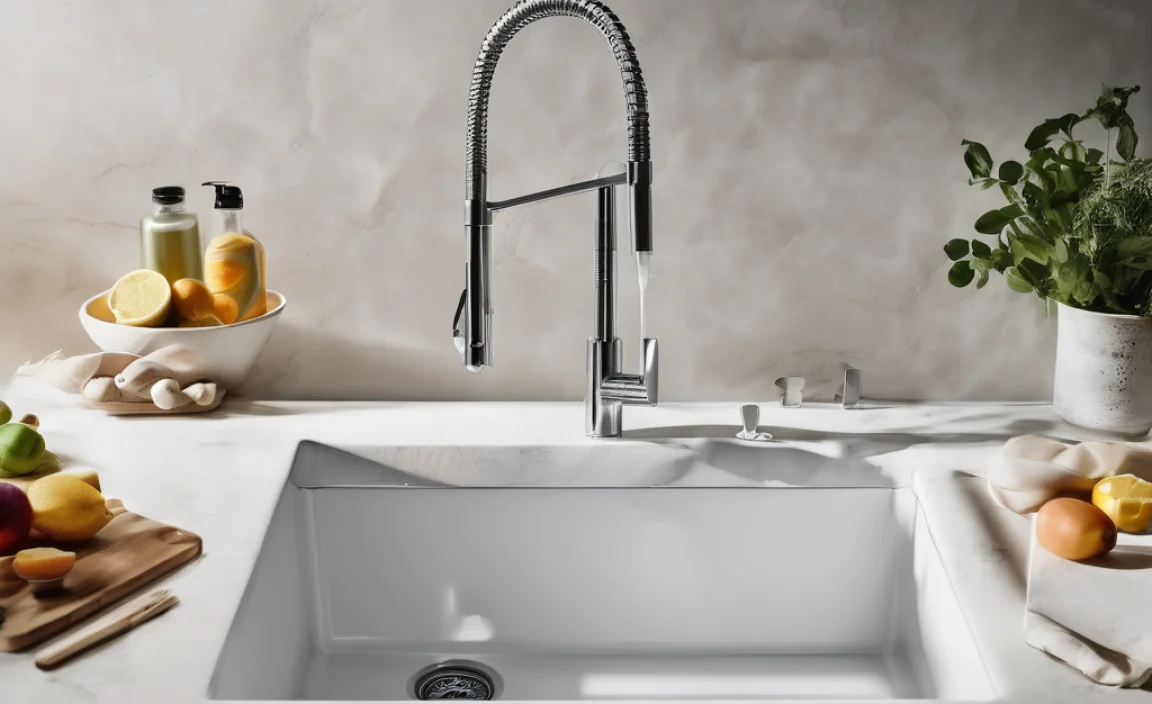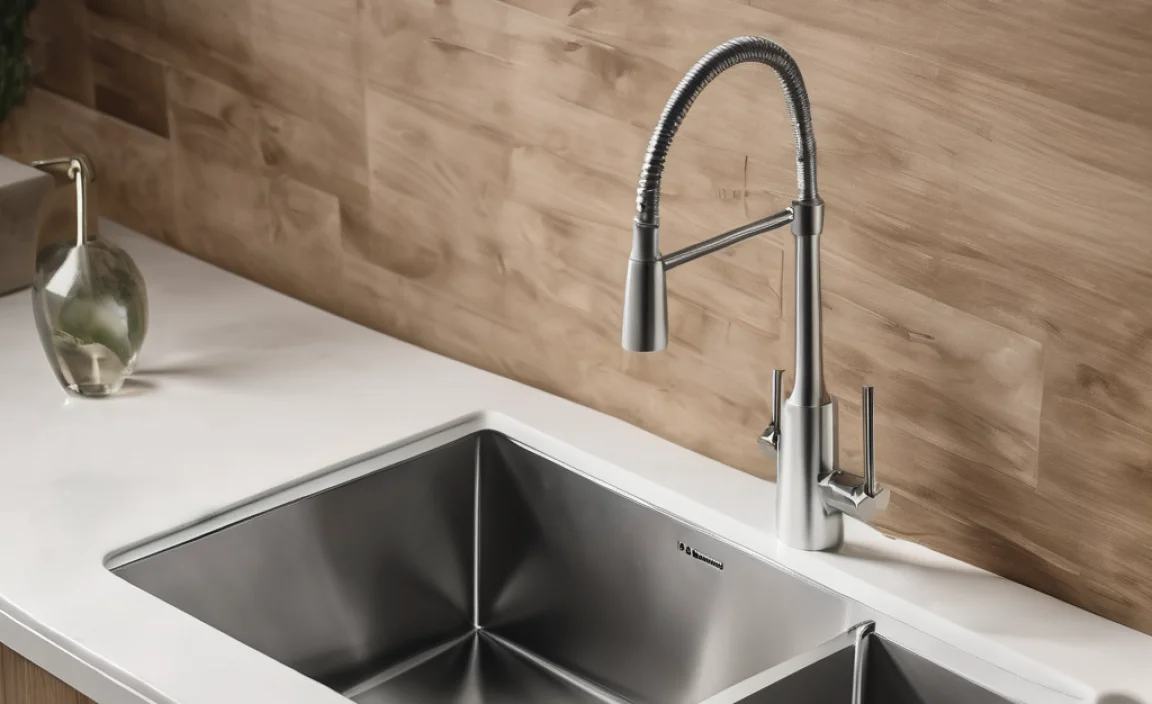Cleaning a Blanco sink is easy! For daily cleaning, use mild soap and water. For tougher stains, try a Blanco cleaner or a baking soda paste. Always rinse well and dry with a soft cloth to keep your sink looking its best. Regular cleaning prevents buildup and keeps your sink sparkling.
Is your Blanco sink looking a bit dull? Don’t worry, it happens! Food, water spots, and everyday use can leave their mark. But don’t stress, bringing back that shine is simpler than you think. With a few basic supplies and some easy steps, you can have your sink looking brand new again.
This guide will walk you through everything you need to know, from daily maintenance to tackling stubborn stains. Get ready to learn how to keep your Blanco sink clean and beautiful for years to come!
Why Cleaning Your Blanco Sink Matters

Keeping your Blanco sink clean isn’t just about appearances. Regular cleaning protects the sink material and ensures a hygienic space. Here’s why it’s important:
- Prevents Stains: Daily cleaning prevents food and mineral buildup that can cause stubborn stains.
- Maintains Hygiene: A clean sink reduces bacteria and germs, keeping your kitchen sanitary.
- Extends Sink Life: Proper care protects the sink’s surface, preventing damage and prolonging its lifespan.
- Enhances Appearance: A sparkling clean sink improves the overall look of your kitchen.
Understanding Blanco Sink Materials

Blanco sinks come in various materials, each requiring specific care. Knowing your sink’s material is the first step in effective cleaning. Here’s a quick overview:
- Granite Composite (Silgranit): Made from granite stone and resin, these sinks are heat, scratch, and stain-resistant.
- Stainless Steel: Durable and classic, stainless steel sinks are resistant to rust and corrosion.
- Fireclay: These sinks are made from clay fired at high temperatures, resulting in a smooth, durable surface.
This article focuses primarily on granite composite (Silgranit) sinks, as they are very popular and require specific cleaning techniques. However, tips for stainless steel sinks are included as well.
Supplies You’ll Need

Before you start, gather these essential cleaning supplies:
- Mild Dish Soap: For daily cleaning.
- Soft Sponge or Cloth: Avoid abrasive materials that can scratch the sink.
- Baking Soda: A gentle abrasive for removing stains.
- White Vinegar: Helps dissolve mineral deposits and hard water stains.
- Blanco Cleaner: Specially formulated for Blanco sinks (optional).
- Old Toothbrush: For scrubbing hard-to-reach areas.
- Spray Bottle: For applying cleaning solutions.
- Clean, Dry Towel: For drying the sink after cleaning.
Daily Cleaning Routine

A quick daily cleaning routine will prevent buildup and keep your Blanco sink looking its best.
- Rinse the Sink: Rinse the entire sink with warm water to remove loose debris.
- Apply Soap: Squirt a small amount of mild dish soap onto a soft sponge or cloth.
- Scrub Gently: Gently scrub the sink surface, paying attention to areas with food residue or water spots.
- Rinse Thoroughly: Rinse the sink completely with warm water to remove all soap residue.
- Dry the Sink: Use a clean, dry towel to dry the sink. This prevents water spots and mineral buildup.
Dealing with Common Stains

Even with daily cleaning, stains can sometimes appear. Here’s how to tackle common types of stains on your Blanco sink:
Water Spots
Water spots are caused by mineral deposits from hard water. Here’s how to remove them:
- Vinegar Solution: Mix equal parts white vinegar and water in a spray bottle.
- Spray and Soak: Spray the solution onto the water spots and let it sit for 10-15 minutes.
- Scrub Gently: Use a soft sponge or cloth to gently scrub the affected areas.
- Rinse and Dry: Rinse the sink thoroughly with warm water and dry with a clean towel.
Food Stains
Food stains, like coffee or tea stains, can be removed with baking soda:
- Baking Soda Paste: Make a paste of baking soda and water.
- Apply to Stain: Apply the paste to the stain and let it sit for 15-20 minutes.
- Scrub Gently: Gently scrub the area with a soft sponge or cloth.
- Rinse and Dry: Rinse the sink thoroughly and dry with a clean towel.
Grease Buildup
Grease can accumulate over time, making the sink feel sticky. Here’s how to remove it:
- Hot Water and Soap: Fill the sink with hot, soapy water.
- Soak: Let the solution soak for 30 minutes to loosen the grease.
- Scrub: Use a sponge or brush to scrub away the grease.
- Rinse and Dry: Drain the sink, rinse thoroughly, and dry with a clean towel.
Deep Cleaning Your Blanco Sink
For a more thorough cleaning, follow these steps:
- Clear the Sink: Remove all items from the sink, including dish racks and soap dispensers.
- Rinse: Rinse the sink with warm water to remove any loose debris.
- Apply Cleaner: Apply Blanco cleaner or a baking soda paste to the entire sink surface.
- Scrub: Use a non-abrasive sponge or brush to scrub the sink, paying attention to corners and edges.
- Let it Sit: Allow the cleaner to sit for 15-20 minutes to break down stains and buildup.
- Rinse Thoroughly: Rinse the sink completely with warm water until no cleaner remains.
- Dry: Dry the sink with a clean, dry towel to prevent water spots.
- Polish (Optional): For extra shine, use a microfiber cloth to polish the sink surface.
Specific Cleaning Tips for Silgranit Sinks
Silgranit sinks require special attention to maintain their appearance. Here are some specific tips:
- Avoid Abrasive Cleaners: Do not use abrasive cleaners or scouring pads, as they can scratch the surface.
- Use Blanco Cleaner: For tough stains, use Blanco’s specially formulated cleaner for Silgranit sinks.
- Remove Food Quickly: Clean up food residue promptly to prevent staining.
- Regular Cleaning: Consistent cleaning prevents buildup and keeps the sink looking new.
Cleaning Stainless Steel Blanco Sinks
While this article focuses on Silgranit, here are tips for stainless steel Blanco sinks:
- Use Stainless Steel Cleaner: Use cleaners specifically designed for stainless steel.
- Clean with the Grain: Wipe the sink in the direction of the grain to avoid scratches.
- Avoid Chlorine Bleach: Do not use chlorine bleach, as it can damage stainless steel.
- Rinse and Dry: Always rinse and dry the sink after cleaning to prevent water spots.
DIY Cleaning Solutions
If you prefer homemade cleaning solutions, here are a few effective options:
- Baking Soda and Vinegar: Create a paste of baking soda and vinegar for scrubbing stains.
- Lemon Juice: Use lemon juice to remove hard water stains and freshen the sink.
- Hydrogen Peroxide: Mix hydrogen peroxide with baking soda to create a powerful stain remover.
Maintenance Tips for Blanco Sinks
Follow these maintenance tips to keep your Blanco sink in top condition:
- Use a Sink Grid: Protect the sink bottom from scratches with a sink grid.
- Avoid Dropping Heavy Objects: Be careful not to drop heavy objects into the sink, which can cause chips or cracks.
- Flush Drains Regularly: Flush the drains with hot water to prevent clogs.
- Avoid Harsh Chemicals: Do not use harsh chemicals like drain cleaner, which can damage the sink surface.
Troubleshooting Common Problems
Here are solutions to common problems you might encounter while cleaning your Blanco sink:
| Problem | Solution |
|---|---|
| Stubborn Stains | Use a baking soda paste or Blanco cleaner and let it sit longer before scrubbing. |
| Water Spots | Apply a vinegar solution and scrub gently. Dry the sink thoroughly after rinsing. |
| Grease Buildup | Soak the sink in hot, soapy water and scrub with a brush. |
| Clogs | Use a drain snake or a mixture of baking soda and vinegar followed by hot water. |
Best Practices for Sink Hygiene
Maintaining a hygienic sink is crucial for a healthy kitchen. Here are some best practices:
- Clean Regularly: Clean your sink daily to prevent bacteria and germs from accumulating.
- Disinfect: Occasionally disinfect the sink with a mild bleach solution (for stainless steel) or a disinfectant spray.
- Clean Sponges: Regularly clean or replace your sponges to prevent the spread of bacteria.
- Wash Hands: Always wash your hands thoroughly after handling raw meat or other potentially contaminated items.
Cost-Effective Cleaning Solutions
Cleaning your Blanco sink doesn’t have to break the bank. Here are some cost-effective solutions:
- Baking Soda: A versatile and inexpensive cleaner for stains and odors.
- White Vinegar: A natural disinfectant and cleaner for hard water stains.
- Dish Soap: Effective for daily cleaning and grease removal.
- Lemon Juice: A natural cleaner and deodorizer.
Step-by-Step Guide: Cleaning a Blanco Sink
Here’s a detailed step-by-step guide to cleaning your Blanco sink:
- Gather Supplies: Collect your cleaning supplies, including mild dish soap, baking soda, white vinegar, a soft sponge, and a clean towel.
- Rinse the Sink: Rinse the sink with warm water to remove any loose debris.
- Apply Soap: Squirt a small amount of mild dish soap onto a soft sponge.
- Scrub Gently: Gently scrub the sink surface, paying attention to areas with food residue or water spots.
- Address Stains: For stains, apply a baking soda paste or a vinegar solution and let it sit for 15-20 minutes before scrubbing.
- Rinse Thoroughly: Rinse the sink completely with warm water to remove all soap and cleaner residue.
- Dry the Sink: Use a clean, dry towel to dry the sink. This prevents water spots and mineral buildup.
- Inspect: Check the sink for any remaining stains or buildup and repeat the cleaning process if necessary.
How to Prevent Future Stains
Preventing stains is easier than removing them. Here’s how to keep your Blanco sink looking new:
- Rinse After Use: Rinse the sink after each use to remove food particles and residue.
- Dry the Sink: Dry the sink after each use to prevent water spots.
- Use a Sink Grid: Protect the sink bottom from scratches and stains with a sink grid.
- Avoid Harsh Chemicals: Do not use harsh chemicals that can damage the sink surface.
- Regular Cleaning: Maintain a regular cleaning schedule to prevent buildup.
Choosing the Right Cleaning Products
Selecting the right cleaning products is essential for maintaining your Blanco sink. Here’s a comparison of popular options:
| Product | Pros | Cons |
|---|---|---|
| Mild Dish Soap | Gentle, effective for daily cleaning, readily available. | May not remove tough stains. |
| Baking Soda | Natural, abrasive, removes stains and odors. | Can be messy. |
| White Vinegar | Natural, disinfects, removes hard water stains. | Strong odor. |
| Blanco Cleaner | Specially formulated for Blanco sinks, effective on tough stains. | More expensive. |
Frequently Asked Questions (FAQ)
How often should I clean my Blanco sink?
Clean your Blanco sink daily with mild soap and water to prevent buildup. Deep clean it weekly or as needed to remove stains.
Can I use bleach on my Blanco sink?
Avoid using bleach on Silgranit sinks, as it can damage the material. For stainless steel sinks, use diluted bleach sparingly.
What is the best way to remove hard water stains?
Use a solution of equal parts white vinegar and water. Spray it on the stains, let it sit for 10-15 minutes, then scrub gently and rinse.
How do I clean a stained Blanco Silgranit sink?
Make a paste of baking soda and water, apply it to the stain, let it sit for 15-20 minutes, then scrub gently and rinse.
Can I use abrasive cleaners on my Blanco sink?
No, avoid using abrasive cleaners or scouring pads, as they can scratch the surface of Blanco sinks, especially Silgranit.
How do I prevent water spots on my Blanco sink?
Dry the sink with a clean, dry towel after each use to prevent water spots and mineral buildup.
Is it safe to use vinegar on my Blanco sink?
Yes, white vinegar is safe to use on Blanco sinks for removing hard water stains. Just be sure to rinse thoroughly afterward.
Conclusion
Keeping your Blanco sink clean and sparkling is easier than you think! By following these simple steps and tips, you can maintain its beauty and extend its lifespan. Remember to clean regularly, address stains promptly, and use the right cleaning products for your sink’s material. With a little effort, your Blanco sink will continue to be a stunning and hygienic focal point in your kitchen for years to come.
